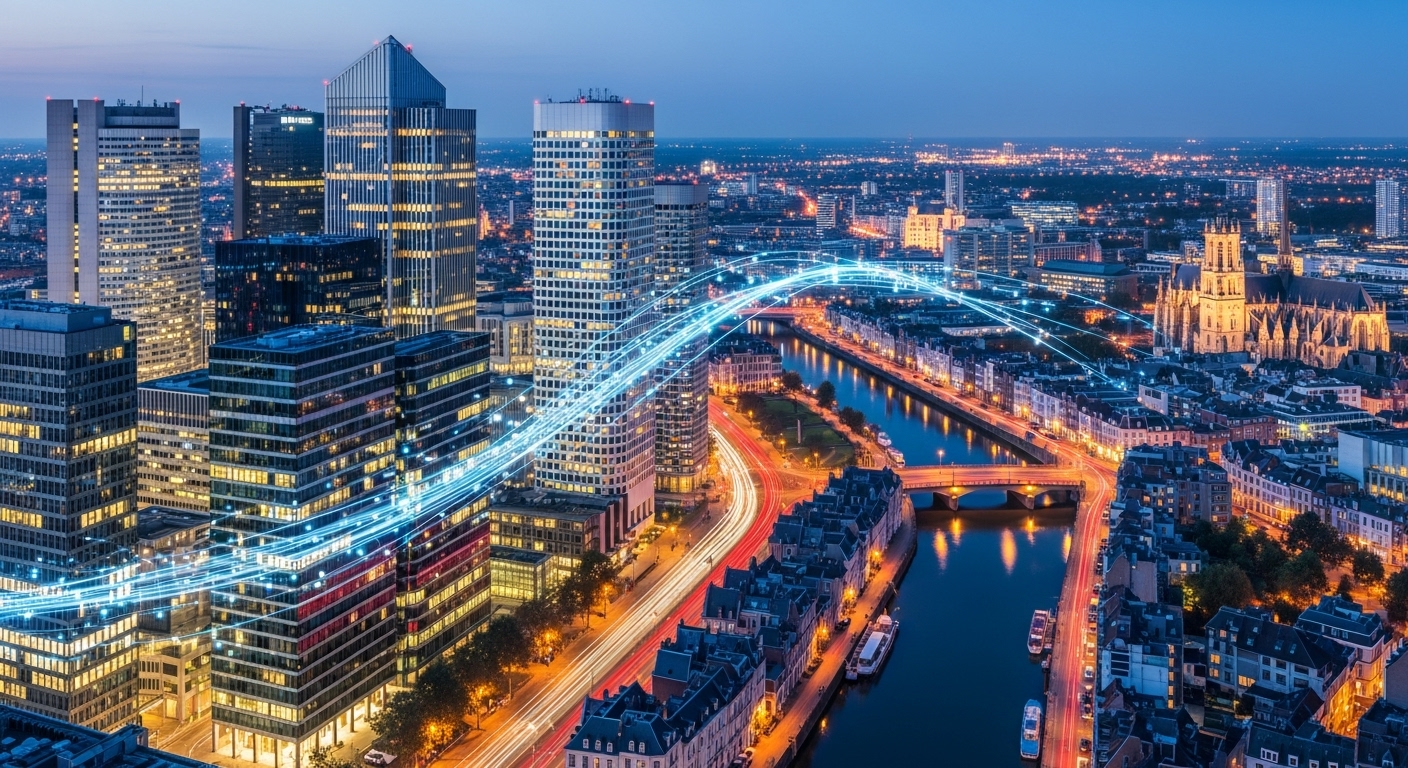In the dynamic post-pandemic and post-Brexit landscape, selecting a European base of operations has become more complex than ever. The old model of choosing a city based on a single dominant industry—finance in London, manufacturing in Germany—is rapidly becoming obsolete. Today, the most resilient and attractive European business districts are defined not by a single specialty, but by a powerful convergence. This is the strategic interplay of a skilled talent pool, cutting-edge technological infrastructure, and seamless trade and logistics networks. Understanding this convergence is the key to unlocking sustainable growth and competitive advantage on the continent. For global leaders and expansion strategists, simply identifying a city is not enough; the real task is to map how these crucial elements intersect to create a thriving ecosystem tailored to their specific business needs. This analysis moves beyond surface-level rankings to provide a strategic blueprint, exploring the financial powerhouses, tech titans, and trade gateways that exemplify this new paradigm and offering a framework for making the optimal location decision.
The New Calculus: Redefining the Premier European Business District
The criteria for what constitutes a ‘premier’ business district in Europe have fundamentally shifted. Legacy locations built on industrial might or financial dominance are now being evaluated through a new, multifaceted lens. The modern calculus prioritizes resilience, adaptability, and quality of life alongside traditional economic metrics. At the forefront of this shift is the demand for a deep and diverse talent pool. Companies are no longer just looking for specific skills; they seek ecosystems with world-class universities, a vibrant international community, and a high quality of life that attracts and retains top professionals. Cities that offer excellent public transport, green spaces, and cultural amenities are gaining a significant competitive edge. Another non-negotiable factor is digital connectivity. A district’s value is now intrinsically linked to its fiber-optic infrastructure, 5G coverage, and data center capacity. This digital backbone is essential for supporting everything from AI development and cloud computing to the seamless operation of hybrid work models. As one analyst from a leading real estate firm noted:
‘Five years ago, clients asked about rent per square foot first. Now, the first questions are about fiber connectivity and the local talent pipeline. It’s a complete inversion of priorities.’
Furthermore, Environmental, Social, and Governance (ESG) criteria are no longer a peripheral concern but a core component of site selection. Businesses are under increasing pressure from investors and consumers to operate sustainably. Consequently, districts with a high concentration of green-certified buildings, robust public transit, and clear municipal commitments to carbon neutrality are becoming magnets for foreign investment. This new calculus demands a holistic view, forcing decision-makers to weigh a city’s cultural vibrancy, digital readiness, and environmental stewardship as heavily as its economic output.
The Financial Powerhouses: Where Capital and Innovation Collide
Europe’s traditional financial centers are not resting on their laurels; they are actively reinventing themselves as hubs where capital and technological innovation collide. London’s Square Mile remains a global financial behemoth, but its continued success hinges on its embrace of FinTech. The district is now a dense ecosystem of challenger banks, regtech startups, and blockchain innovators, often working in close proximity to centuries-old financial institutions. This synergy creates a unique environment where deep capital pools fuel cutting-edge technological development. Similarly, Frankfurt’s Bankenviertel, the traditional heart of German finance and home to the European Central Bank, has leveraged its stability and connectivity to become a critical hub for data centers and cloud services catering to the financial industry. Its strategic location in the heart of Europe makes it a nexus for both financial transactions and data flow. In Paris, La Défense is undergoing a significant transformation. Once seen as a monolithic corporate district, it is now diversifying its tenant base to include tech companies and creative agencies, fostering a more dynamic and collaborative atmosphere. New developments focus on mixed-use spaces, integrating residential and retail elements to create a more vibrant, 24/7 environment. The key to the endurance of these powerhouses is their ability to foster convergence—blending their established financial infrastructure with the dynamism of the tech sector, ensuring they remain the epicenters of European capital and innovation.
The Tech Titans: Navigating Europe’s Digital Frontiers
While established financial hubs evolve, a new class of tech-centric districts has emerged, defining Europe’s digital future. Dublin’s “Silicon Docks” is a prime example of successful convergence, driven by a strategic combination of favorable corporate tax policies, a young, English-speaking talent pool, and a critical mass of global tech giants. The presence of companies like Google, Meta, and LinkedIn has created a powerful network effect, attracting waves of startups, venture capital, and specialized talent to the city’s Grand Canal Dock area. Meanwhile, Berlin stands out for its decentralized and diverse tech scene. Lacking a single central district, its innovation is spread across neighborhoods like Mitte, Kreuzberg, and the emerging Mediaspree, creating a polycentric hub known for its creative energy and relatively lower cost of living. This environment has made it a magnet for bootstrap startups and creative tech ventures. Amsterdam’s Zuidas district presents another model, evolving from a finance and legal hub into a major European headquarters for tech firms. Its world-class digital infrastructure, coupled with Schiphol Airport’s global connectivity and a strong emphasis on work-life balance, makes it exceptionally attractive for international companies looking to establish a pan-European presence. These tech titan districts thrive on a specific formula: strong university partnerships that supply fresh talent, active government support through grants and incentives, and a culture of collaboration that fuels the entire ecosystem.
The Logistics & Trade Nexus: Gateways to the Global Market
In a globalized economy, proximity to efficient trade routes is a powerful strategic advantage. Certain European districts have built their success on being critical gateways for commerce and logistics, merging physical infrastructure with digital innovation. The Port of Rotterdam, Europe’s largest seaport, is the anchor for a sprawling logistics district that is a masterclass in efficiency. It’s not just about the volume of containers; it’s about the sophisticated digital platforms that manage supply chains in real-time, from automated container terminals to blockchain-based customs clearance. This deep integration of technology and trade makes the Rotterdam area an essential hub for any business reliant on the movement of goods into and out of the continent. Similarly, Hamburg’s HafenCity is one of Europe’s most ambitious urban regeneration projects, transforming a former port area into a modern, mixed-use district. It is designed around the principles of sustainability and connectivity, integrating commercial, residential, and leisure spaces with the city’s bustling port. As a key executive for a global logistics firm stated:
‘The future of logistics is not just about moving boxes faster. It’s about data, predictability, and sustainability. Hubs like Hamburg and Rotterdam are building the physical and digital infrastructure for that future.’
These trade nexuses are no longer just points on a map; they are highly integrated ecosystems where physical and digital supply chains converge, offering unparalleled access to the European single market and beyond.
The Challenger Cities: Emerging Hubs of Specialization
Beyond the established giants, a dynamic cohort of ‘challenger’ cities is rising, attracting investment and talent by cultivating specialized ecosystems. Warsaw has rapidly emerged as the business services capital of Central and Eastern Europe. Its districts, like Wola and Mokotów, are filled with the high-rise offices of global corporations drawn by a highly educated, multilingual talent pool and a cost-effective yet high-quality business environment. The city has become a powerhouse for shared service centers, IT, and R&D. Lisbon has reinvented itself as a vibrant tech and creative hub, attracting a global community of entrepreneurs and digital nomads. Favorable visa programs, a burgeoning startup scene fueled by events like the Web Summit, and an enviable quality of life have made it one of Europe’s most talked-about destinations for innovation. Its success demonstrates the power of combining a strong cultural identity with a forward-thinking economic strategy. In Scandinavia, Copenhagen is a leader in life sciences and sustainable technology. The Medicon Valley cluster, which spans Copenhagen and southern Sweden, is one of the world’s premier life science ecosystems, bringing together universities, hospitals, and private companies. Copenhagen’s city-wide commitment to sustainability has also made it a living lab for green tech and smart city solutions. These challenger cities prove that a focused strategy, whether in business services, creative tech, or life sciences, can create a powerful gravitational pull for investment and talent.
Strategic Site Selection: A Convergence-Based Framework
Making the right location decision in this complex European landscape requires a strategic framework based on the principle of convergence. A simple cost-benefit analysis is no longer sufficient. Instead, leaders must conduct a holistic assessment that aligns a district’s unique strengths with their company’s core operational needs. The first step is to map your talent requirements. Look beyond just the availability of skills and consider the entire talent ecosystem. Are there leading universities producing relevant graduates? Does the city’s quality of life align with the expectations of the talent you need to attract? Second, conduct a rigorous audit of the technological infrastructure. This includes not only internet speed but also data privacy regulations, the availability of secure data centers, and the maturity of the local tech scene for potential partnerships. Third, evaluate the trade and logistics network. How seamlessly can you move goods, components, and products? Analyze the proximity to major ports, airports, and rail networks, as well as the sophistication of the digital logistics platforms in place. Finally, assess the business and regulatory environment. This includes corporate tax rates, government incentives for R&D or foreign investment, and the overall stability and predictability of the market. By analyzing potential locations through these four interconnected lenses—talent, tech, trade, and regulation—a business can identify the district where these critical factors converge most powerfully to support their specific strategic goals, ensuring a successful and sustainable European presence.
In conclusion, the map of European business districts is being redrawn by the powerful forces of convergence. The premier locations of the future will not be defined by a single strength but by their ability to weave together talent, technology, and trade into a cohesive and resilient ecosystem. From the reinvented financial hubs of London and Frankfurt to the dynamic tech frontiers of Dublin and Berlin, and the rising challenger cities like Lisbon and Warsaw, a diverse array of opportunities exists for businesses that know how to look for them. The key takeaway for any organization planning an expansion or relocation is to move beyond legacy reputations and adopt a strategic, data-driven approach. By analyzing how a location performs across the critical vectors of human capital, digital infrastructure, and logistical efficiency, decision-makers can uncover the ideal hub to drive their growth. In this ever-evolving continent, the most successful companies will be those that understand this new calculus of convergence and choose a home base that doesn’t just meet their needs today, but empowers their ambitions for tomorrow.





